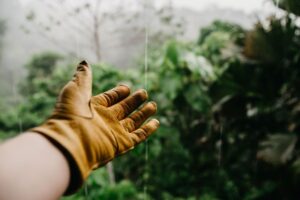Editor’s Note: The author of this op-ed, Joseph CL Merola, MD, MPH, is an active member of the Old Saybrook March for Justice. He lives in Old Saybrook and is a semiretired Obstetrician and Gynecologist, having most recently practiced, taught and served as Chairman of the Department at the St. Luke’s University Health Network in Eastern PA and Western NJ. Dr. Merola also has been a Clinical Associate Professor at the University of Pennsylvania School of Medicine, and Clinical Professor at the Temple University School of Medicine. He has an abiding interest in the public’s health, particularly for women and children, and for distributive justice in health care.

At this time of year, I’m in my glory as an avid gardener in Coastal Connecticut.
So grateful to my Italian father and grandfather for sharing and showing, by example, a gardener’s passion (and frankly requiring me to participate by helping to sow, nurture, weed and pick!) Arising from that hands-on education comes a now more natural understanding of the elements of the growing environment for seeds and plants … temperature, soil quality, water, sun and organic principles.
So here we are again, in early September, with an abundant harvest of herbs, greens, root vegetables, peppers and array of tomato varieties, sizes and colors. And we can still look ahead to corn, squashes and pumpkins for the fall. How wonderful! But, giving credit where credit is due, these “fruits of one’s labor”, and their quality, begin and depend on the all-important environment.
So, let’s consider for a moment “The Gardener’s Tale,” an allegory, first appearing within an article in the American Journal of Public Health in 2000, authored by Camara Phyllis Jones, MD, PhD, MPH, the former President of the American Public Health Association and a Professor at the Harvard School of Public Health. (An Abstract, and access to the full text is available at https://www.ncbi.nlm.nih.gov/pmc/articles/PMC1446334/ for further reference.)
She develops a context for understanding racism on three levels. First is Personally Mediated Racism, i.e. intentional or unintentional prejudice and discrimination, including acts of omission and/or commission, structural boundaries, and societal condonation.
The second is Internalized Racism, wherein the members of the race in question accept notions of their own lesser intrinsic worth and ability.
The last is the so evident Institutionalized Racism, shown by sub-optimal material conditions (access to quality housing, education, employment, a clean environment and particularly health care). Also included in this category is similarly differential access to power, resources, information, and a “voice.”
As a demonstration, Jones presents the referenced allegory of a Gardener with two flower boxes, one with fresh, rich soil (and beautiful red flowers) and the other, unknowingly at first, with old, poor quality soil (and similarly poor quality pink flowers.)
Personally Mediated Racism is reflected in the Gardener’s discard of the scraggly pink blossoms before going to seed, or removing pink scattered seeds that might be blowing into the more fertile soil.
Internalized Racism here relates to the pink flowers telling the bees not to pollinate them with pink pollen, as they prefer red pollen, and thus red flowers.
The allegorical equivalent of Institutionalize Racism is most poignant … with the two flower boxes historically keeping the soils, seeds and flowers separate by color, the oversight of the gardener in not addressing the soil differences in the first place, and the belief that red flowers were intrinsically better!
This summer a light has dramatically been shone on our own “gardens”, in our own shoreline towns. The marches for social justice, arising from the Black Lives Matter movement, have grown in size and number. Privileged people, not directly impacted by racism, have materialized and raised their voices against racism. This has been a powerful maker!
Towns across Connecticut, including New London, have adopted resolutions claiming that “racism is a public health crisis,” and used the opportunity for town hall conversations to bring about change. Why is all quiet in the Old Saybrook, Essex and Old Lyme Town Halls, despite their own residents’ protests and affirmation?
Clearly, “the Gardener” here is our local government. They have the power to consider, act, and openly declare racism as a reality, a grave concern, and a public health crisis. They have the power to allocate more resources to mitigate this dilemma. Among other outcomes, these could take the shape of education, public culture, affordable housing and accessible healthcare.
But, why are they so quiet?
We need open recognition, and declaration: our various garden environments for growth must be optimized, and not different. Our racial soil quality, particularly new and fertile soil, is needed to permit pink flowers to flourish, as well as red. Then, flowers of all colors can be recognized equally, and have the same opportunity for contributing to a brighter and more meaningful life.
Well said, thank you for the thoughtful and insightful ideas.